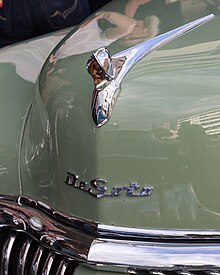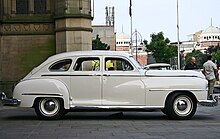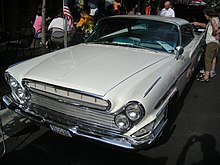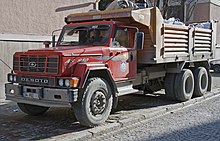DeSoto (car brand)
DeSoto was an automobile brand from the United States that belonged to the Chrysler Corporation and was mainly sold in the North American market from 1928 to 1961. DeSoto offered passenger cars that were technically and stylistically closely based on the respective Chrysler models. In addition, heavy trucks were built under the brand name that were built outside of the United States, particularly in Turkey . Their production continued until 1978.
history
History of origin
The DeSoto brand was founded on August 4, 1928 by Walter P. Chrysler . It was named after the Spanish conquistador Hernando de Soto , who had undertaken expeditions to Central America and through southern North America in the 16th century.
The Chrysler Corporation, founded in 1925, was only represented in the US market with the Chrysler brand for the first three years of its existence. In contrast, General Motors sold numerous brands that covered very different price segments; At times, up to 10 brands belonged to the General Motors group, some of which, however, were only very short-lived. Also Studebaker and Willys-Overland talked with Erskine and Whippet additional brands.
Chrysler followed suit with the establishment of the Plymouth brands in June 1928 and DeSoto in August of the same year. DeSoto was positioned in a mid-market segment between the other two brands. This enabled Chrysler to be present in the mid-range segment without affecting the reputation of its own brand, which was associated with high-priced cars.
Shortly after the introduction of the DeSoto brand, Chrysler also took over the automobile manufacturer Dodge Brothers Inc , founded in 1914 , which was also located in a market segment below Chrysler. Chrysler Corporation now had one brand in the lower middle class and two in the middle price segment. Some reports claim that Chrysler would not have formed DeSoto if it had been able to acquire Dodge earlier; other sources claim that Chrysler established the DeSoto brand with the aim of lowering the purchase price for Dodge. The group has now positioned DeSoto in a market segment between Dodge and Chrysler and Plymouth in the market below Dodge. From 1929 onwards, the Chrysler Corporation had a total of four brands in different price ranges on offer.
1929-1942
In the early years, Chrysler's two-brand strategy was relatively successful in the middle class. In the first model year, DeSoto produced 81,065 vehicles. That was a record for a newly founded American automobile brand. This success lasted for almost 30 years. Notwithstanding the global economic crisis remained DeSoto sales relatively stable in 1932, emissions of Dodge was exceeded by about 25,000 vehicles.
In 1933, the DeSoto group moved closer to the Chrysler brand, with the aim of increasing the distance to Dodge and thereby improving Dodge sales. This realignment resulted in DeSoto adopting the streamlined Airflow design in 1934 , which debuted that year at the Group's top brand as Chrysler Airflow . The design was as progressive as it was polarizing. It turned out to be too ambitious for the American market, so that neither the high-priced Chrysler version nor the slightly cheaper and shorter DeSoto Airflow were successful. DeSoto's location was particularly problematic compared to the group's sister brands. While Dodge and Plymouth did not offer any Airflow versions at all, but only had conventionally designed vehicles in their range, Chrysler was able to compensate for the weak sales figures of its Airflow in any case with conventional models that the brand had in its range at the same time. DeSoto, on the other hand, was the only group brand to offer exclusively Airflow models in 1934. That led to a dramatic drop in sales; In 1934 DeSoto only produced 13,940 vehicles, about half of the previous year's output. From 1935 the conventionally designed Airstream models appeared, which helped to make up for the deficits. For the rest of the 1930s, the DeSotos got "bigger and more boring". The design was conservative, but it suited customers' tastes. Sales during this period were further stimulated by commercials with Spencer Tracy and Walt Disney .
The 1942 DeSoto model (S10) was the first mass-produced car with pop-up headlights on the North American market. Pop-up headlights first appeared in 1935 on the Cord 810 , a luxury vehicle designed by Gordon Buehrig , and Chrysler picked them up in 1941 on the Newport Show Car. DeSoto marketed this design feature as “ Air-Foil ” lights and advertised them with the slogan: “Ouf sight, except at night” (German roughly: “Not to be seen, except at night”). Pop-up headlights were only offered in the 1942 model year. Another design feature of the 1942 vintage was a radiator grille with vertical chrome struts that ran the full width of the car. They remained - in different variations - until 1955 as a special trademark of all DeSoto models. Chrysler delivered the DeSoto in two trim levels - "Deluxe" and "Custom" - and there were two wheelbases to choose from - 121.5 and 139.5 inches (3086 and 3543 mm). The chassis were available with different bodies, including a “business coupé” with a short wheelbase, two or four-door sedans with a short or long wheelbase, and even seven-seat taxis with a long wheelbase. The engine with 237 ci (3.8 l) displacement developed 115 hp (86 kW).
The 1942 DeSotos were only produced for a few months. At the beginning of 1942, DeSoto, like all other North American automobile plants, stopped manufacturing civil vehicles due to the war. A total of less than 25,000 vehicles were built, which today - not least because of the pop-up headlights - are among the classics sought after.
1946-1960
New start with pre-war models
In 1946 DeSoto took up the production of civil automobiles again. The vehicles of the model years 1946 to 1948 largely corresponded technically and stylistically to the 1942 models; however, the DeSoto range was less versatile than before the war. The design had been slightly revised. The front pop-up headlights were replaced by round individual headlights that were embedded in the front fenders. The fenders were less pronounced and merged smoothly into the body in the area of the front doors. The vehicles had a box-frame chassis, independent wheel suspension at the front and rear, the rigid axle that was still common in the USA for a long time . The DeSoto six-cylinder engines were side-controlled . A semi-automatic gearbox from Gyrol Fluid Drive with hydraulic clutch , which was operated by means of tip-toe (push button selection), was already part of the scope of services.
In addition to the regular models, DeSoto offered extended wheelbase versions that were used as taxis , airport shuttles, and hotel vehicles. These versions remained in the program until 1955.
New bodies and engines
For the 1949 model year, DeSoto, like the other Chrysler brands, presented completely redesigned vehicles. They had a pontoon-like structure, which increased the space inside. The Diplomat and Diplomat Custom models , which were derived from the Plymouth model series, were designed as export models that were offered with a 2.8-liter in-line six-cylinder engine. In 1951, Chrysler's Oriflow shock absorbers were introduced as a technical innovation. In addition to the introduced last year Faux Cabriolet Sportsman there was now a station wagon ( "station wagon" ), which was offered without wooden planking with retractable rear window.
With the 1951 model year, the vertical decorative bars on the radiator grille were given up in favor of vertical tooth-like ribs. For a while, similar decorative elements were used on the Opel Olympia Rekord in Germany. The engine output was already 117 hp. Until 1952 DeSoto used the designations Deluxe and Custom as model names.
A new eight-cylinder engine was added to the range for the 1952 model year. It was DeSoto's first eight-cylinder engine since 1932 and also the first eight-cylinder in V design . The V8, known as Fire Dome Eight , was based on Chrysler designs. It had a displacement of 276 cubic inches (4,255 cm³) and made 160 hp in the first version. The engine had inclined valves and hemispherical combustion chambers. It was produced in a modern, partially automated factory in Dearborn , which carried out up to 96 operations in 34 steps using precision machines. The in-line six-cylinder with the designation Powermaster , the design of which dates back to the 1930s, remained in the range until 1955; however, the only 116 hp unit sold increasingly poorly.
In 1953 the model names Deluxe and Custom were dropped. The six-cylinder models were henceforth called Powermaster Six and the V8 models as Firedome 8 . At its peak, the Firesweep , Firedome and Fireflite were among De Soto's most popular models. The semi-automatic transmission was modified by a hydraulic torque converter, which no longer required a separate oil, but was also supplied by the engine oil. With the 1954 model year, the Chrysler Group's first fully automatic transmission, the Power-Flite transmission, was also offered for DeSoto. As early as 1953, the Coupé Adventurer was built by Ghia in Turin as a “dream car”. With the decreasing interest in the six-cylinder models, these disappeared from the program. The Firedome and Fireflite models remained with the V8 engines, which already had more than 200 hp. The Diplomat and Diplomat Custom models continued to be manufactured for export . The DeSoto Adventurer presented in 1956 as a hardtop coupé grew to a full range of model versions by 1960.
The Hundred Million Dollar Look
For the 1955 model year, Chrysler introduced a new generation of models across the Group, which was advertised as the Hundred Million Dollar Look . The name was due to the fact that Chrysler had invested about 100 million US dollars in the development of this family. Virgil Exner was responsible for the body design .
With the exception of the DeSoto Diplomat , which was only intended for export , which was a visually only slightly modified Plymouth made in Canada, all DeSoto models from 1955 and 1956 were derived directly from Chrysler vehicles. The DeSotos and Chryslers used the same bodyshell and wheelbase, while the Dodge and Plymouth models were each 4 inches (10 cm) shorter. New to the DeSotos was an electrical system with 12 volts. Outwardly, the DeSotos resembled the Chrysler Windsor, but they had independently designed front and rear sections.
For the 1956 model year, all DeSotos received a facelift. This included a revised front section, which for the first time since 1942 no longer had vertical struts in the radiator grille, but a barred radiator grille, in front of which there were two conspicuous, chrome-plated horns that resembled the so-called Dagmar Bumpers on Cadillac. The rear fenders were also new; they ended in tail fins, under which three round tail lights were arranged one above the other on each side.
The DeSotos of the model years 1955 and 1956 were positioned in competition with the vehicles from Mercury , Buick and Oldsmobile . They sold well by DeSoto standards. In 1955 over 115,000 copies were sold, the following year there were another 110,000. However, the sales figures did not reach the level of the direct competitors, and the other Chrysler brands - apart from the upper-class brand Imperial - were also stronger.
The forward look
In 1957, the De Soto models, like all vehicles from the Chrysler Group, were completely redesigned by Virgil Exner. The design pattern was now called Forward Look . The new bodies of all Chrysler brands were lower and had greatly enlarged panoramic windows . Exner gave the DeSoto soaring tail fins that had triple taillights recessed, prompting buyers to buy the car in record numbers.
The 1957 DeSoto had an integrated design in two flavors: a full hardtop Sportsman coupe body based on a Dodge , a four-door hardtop and a conventional sedan. All models were based on the chassis of Chrysler models. Between the two there were variations in the design of the front, especially in the headlight zone, with the Sportsman featuring two twin- beam headlights and a less aerodynamic front, while the larger models featured the quad design popular at the time . At that time it was customary to subject the design of the models to a facelift every three years : trim strips, bumpers and other low-cost modifications were revised, mainly with additional bumpers, changes in the shape of the headlights, changes in the colors, display instruments and the design of the Vehicle interior. The two 1957 designs were nearly ideal and balanced, so the 1958 model didn't necessarily represent an improvement (especially in the front bumper design).
For all their stylistic attractiveness, the DeSotos of the 1957 model year were poor in terms of quality. With all brands of the Chrysler group, the manufacturing quality had declined in 1957 compared to previous years; at DeSoto, however, the shortcomings were particularly serious. The press reported about it extensively and in detail. As a result, in the following year, many car buyers did not consider the DeSoto brand when buying a new car. This problem was specific to DeSoto. It exacerbated the effects of the economic recession of 1958, which all American automobile manufacturers suffered from, especially for this brand. Quality deficiencies and the recession together resulted in a drop in sales of more than 65 percent at DeSoto 1958: Compared to 117,000 vehicles in 1957, DeSoto sold just under 50,000 cars in the 1958 model year; that was the lowest production volume since 1938. The brand had thus fallen from eleventh to 13th place and was still behind the newly introduced Ford brand Edsel, which was generally perceived as unfortunate .
Chrysler management then relocated the production of DeSoto models from Warren, Wyoming , to the Jefferson North Assembly Plant in Detroit . Here the DeSotos were created parallel to the vehicles of the Chrysler brand. The sensational manifold injection engine from Bendix , which was offered last year, has been removed from the range. Nevertheless, DeSotos still had model variants with more than 350 hp. That did not lead to success: In the 1959 model year, production fell to just over 45,000 vehicles.
The last few years
For the 1960 model year, Chrysler's management merged the previously independent brands Plymouth and DeSoto to form the Plymouth DeSoto Division . In the same year, the company introduced the self-supporting body for all brands - and thus also for DeSoto . This step required large quantities in order to amortize the investment in the expensive press tools . The range of products on offer was therefore limited to the Fireflite and Adventurer models . In terms of style, the DeSoto models largely corresponded to Chrysler's vehicles. They still followed Exner's forward look, but here and there had very conspicuous tail fins that were already in the area of the front doors and were connected to a continuously rising belt line from then on. Sales continued to decline. In the 1960 model year, DeSoto only sold 25,500 vehicles.
When the 1961 model year was presented in the fall of 1960, rumors were already circulating that Chrysler would discontinue the brand.
With the 1961 model year, DeSoto lost its series features, which was reminiscent of the end at Packard . And like the last Packards (often ridiculed as Packardbaker ), the last DeSoto also had a questionable design. Again, the De Soto was based on the smaller chassis of the Chrysler Windsor , had a two-layer grille (each layer with a different surface), inclined double headlights and modified shark-nosed tail lights. Only a two-door and a four-door sedan were offered. The vehicles were trimmed to the design of the 1960 Fireflite.
Although the decision to discontinue DeSoto was made earlier, at the time of the announcement Chrysler warehouses had DeSoto components valued at several million dollars. So the company started up production again to dismantle the otherwise unusable parts. Over 3,000 units were still produced. The DeSoto brand was discontinued on November 30, 1960, 47 days after the 1961 model year was announced, without internal support and interest from dealers and without customer trust. Chrysler and Plymouth dealers who were forced to purchase DeSotos due to their franchise agreements , received no compensation from Chrysler for the unsold DeSotos at the time of the formal announcement. On the contrary: Chrysler continued to deliver the DeSoto car heaps in December 1960. Many of these vehicles were sold at high losses by dealers just to get rid of the vehicles.
Closure factors
Despite Chrysler's mid-range success for most of the period, DeSoto's failure was caused by a combination of corporate errors and external factors beyond Chrysler's control. The 1958 recession hit DeSoto first because it hit the demand for mid-range cars particularly hard. De Soto failed to overcome this crisis in 1959 and 1960. Because of the development costs, the brand did not earn enough to promote its dealer network and support the production costs. When DeSoto's sales fell in 1959 and 1960, it was obvious to Chrysler that DeSoto as a brand had too few regular customers to carry further developments.
The Chrysler dealer network also had an impact on the discontinuation of the DeSoto brand. After World War II , Chrysler had a large number of dealerships selling two or more brands of Chrysler, the Plymouth-DeSoto and Chrysler-Plymouth combination being the most common. When Chrysler then tried to urge dealers to sell only a single brand, they naturally chose Plymouth as the better-selling brand compared to DeSoto, which sold more difficult, which means that the DeSoto brand with a thinned dealer network subsequently sold even worse - a spiral downwards.
But it was the Chrysler Group's brand management that played off each of the five Chrysler brands against each other, causing the greatest damage to DeSoto and ultimately to the Group's long-term product planning. Chrysler's price differentiation was not managed as carefully as General Motors had previously successfully demonstrated, and the various brand divisions were not prevented from developing products that targeted the sister brand's market segment. Dodge has been the most successful so far with the introduction of the Dodge Dart , with the ads comparing the benefits of the dart to the "C" car, the "F" car, and the "P" car - Chevrolet , Ford and Plymouth. Sales of the dart exploded in 1960, but did so at the expense of Dodge sister Plymouth, who suffered a decline in sales due to the darts.
When Chrysler marketing realized that customers were more willing to buy an entry-level Chrysler than a DeSoto, Chrysler introduced the Chrysler Newport as a 1961 model in 1960 , of which they sold 45,000 units in the first year alone.
Although countless collectors claim to have the last DeSoto sold, the system of DeSoto's vehicle identification numbers has been changed in the last few days, which is why the “last” DeSoto with any number may have been produced in the second half of November 1960.
Car models
commercial vehicles
Chrysler Corporation began using the DeSoto brand name in export markets for light and heavy commercial vehicles since 1937. These were initially trucks from overproduction of the sister brands Dodge and Fargo , which were sold with changed brand names in South America and Southeast Asia.
After the end of World War II, the DeSoto brand name appeared sporadically on trucks manufactured by local Chrysler subsidiaries in Argentina, Australia, Great Britain, Spain and Turkey. From 1964 to 1978 Askam , a former subsidiary of Chrysler Corporation based in Istanbul , produced trucks with the brand name DeSoto. Use of the trademark ended in 1978 after Chrysler sold its shares in the company.
Trivia
- Weird Al Yankovic mentions a 1953 DeSoto in the Minnesota song The Biggest Ball of Twine .
- In the comic strip The Piranha Club , Ernie Floyd drove a dark red 1957 DeSoto Fireflite.
- In the comic strip Shoe , the main character, "Perfesser" Cosmo Fishhawk, drives a pink 1959 DeSoto.
- In the 1958 Alfred Hitchcock classic Vertigo , the main character, Detective John "Scottie" Ferguson, drives a gray 1956 DeSoto Firedome.
- A 1960 DeSoto personnel carrier serves as the main means of transport for the cartoon characters Sam & Max and was also used in the computer game Sam & Max Hit the Road and its successors and the television series.
- On the 1950s television show Happy Days , Mr. Cunningham mostly drives an old blue 1946 DeSoto.
- In the film U-Boot in Not , the two-man submersible Snark, while searching for the sunken nuclear submarine USS Neptune , comes across a 1952 DeSoto, which was sunk in the sea as a sonar target and which was mistakenly used for the sonar location Boat was held.
- In the novel The Hundred Year Old Who Climbed Out the Window and Disappeared , Iran's only armored sedan is a burgundy DeSoto Suburban . This is being prepared by the protagonist Allan Karlsson for a planned assassination attempt on Winston Churchill with an explosive charge and explodes in the course of his escape from the main building of the Iranian secret police.
- In the 5th season of the TV series "Aufachse", the last episode features two Desoto trucks.
See also
literature
- Beverly R. Kimes (Ed.), Henry A. Clark: The Standard Catalog of American Cars 1805-1942. Kraus Publications, 1996, ISBN 0-87341-428-4 .
- John Gunnell (Ed.): The Standard Catalog of American Cars 1946-1975. Kraus Publications, 1987, ISBN 0-87341-096-3 .
- Kit Foster: 1960-61 DeSoto: The End of Adventure. In: Collectible Automobile Magazine. Volume 21, Number 3, October 2004, pp. 34-47.
- Roger Glor: Post War Car . Passenger cars 1945–1960. Benedikt-Taschen-Verlag, 1994, ISBN 3-8228-8994-X , p. 130 ff.
- Wolfgang Blaube: In between high . History of the DeSoto brand. In: Oldtimer Market. August 2015, p. 36 ff.
Web links
- Phil Seeds virtual car museum
- National DeSoto Club
- DeSotoland
- Walter P. Chrysler Club
- DeSoto LKW (in English)
- DeSoto trucks manufactured in Turkey ( Memento from January 13, 2013 in the web archive archive.today )
Individual evidence
- ↑ a b Wolfgang Blaube: Zwischenhoch . History of the DeSoto brand. In: Oldtimer Market. August 2015, p. 38.
- ↑ a b c History of the DeSoto brand on the website www.allpar.com (accessed on July 14, 2015).
- ↑ a b c d Wolfgang Blaube: Zwischenhoch . History of the DeSoto brand. In: Oldtimer Market. August 2015, p. 40.
- ↑ Richard M. Langworth: Encyclopedia of American Cars 1930–1980 . Beekman House, New York 1984, ISBN 0-517-42462-2 , p. 223.
- ^ Image of the Chrysler Newport on the website www.imperialclub.com (accessed on July 14, 2015).
- ↑ a b Description of the DeSoto models from the 1940s on the website www.allpar.com (accessed on July 14, 2015).
- ↑ Richard M. Langworth: Encyclopedia of American Cars 1930–1980 . Beekman House, New York 1984, ISBN 0-517-42462-2 , p. 224.
- ↑ Richard M. Langworth: Encyclopedia of American Cars 1930–1980 . Beekman House, New York 1984, ISBN 0-517-42462-2 , p. 225.
- ↑ Richard M. Langworth: Encyclopedia of American Cars 1930–1980 . Beekman House, New York 1984, ISBN 0-517-42462-2 , p. 227.
- ^ History of the Hundred Million Dollar Look on www.allpar.com (accessed July 15, 2015).
- ^ A b Richard M. Langworth: Encyclopedia of American Cars 1930–1980. Beekman House, New York 1984, ISBN 0-517-42462-2 , p. 392.
- ^ Wolfgang Blaube: intermediate high . History of the DeSoto brand. In: Oldtimer Market. August 2015, p. 43.















